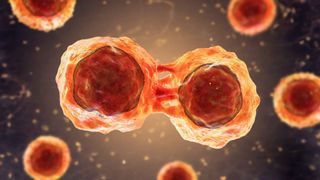
After receiving stem cells (illustrated here) from a donor, a man with HIV entered long-term remission, with no signs of viral rebound in his body.
(Image credit: Dr_Microbe via Getty Images)
A sixth person is in long-term remission from HIV following a stem cell transplant, scientists reported this week at a major HIV research conference — but the patient’s case differs dramatically from earlier ones, and it cannot yet be explained.
“What has happened to me is wonderful and magical,” the anonymous patient said in a statement. “We can now focus on the future.”
The man, referred to as the “Geneva patient,” had both cancer and HIV at the time of his transplant procedure. He’d been living with HIV since the early 1990s, when he began taking anti-HIV medication, known as antiretroviral therapy (ART), to suppress the virus and prevent any progression toward AIDS. He later developed an aggressive form of leukemia, a blood cell cancer, and underwent a stem cell transplant in 2018 to treat the condition.
This part of the Geneva patient’s story echoes those of the five people who previously entered remission from HIV after similar transplants. All five of those previous patients had ART-controlled HIV and cancer at the time of their transplants. The transplants primarily served as cancer treatments, but at least in the first five patients’ cases, doctors also used the transplants as an opportunity to treat HIV.
Related: How are people cured of HIV? Here’s everything you need to know
They did this by identifying stem cell donors with a rare HIV-resistant genetic mutation. That mutation, called CCR5-delta 32, disables a protein on the surface of human cells that most HIV strains use to break inside and jump-start infection. Once inside a patient’s body, the HIV-resistant transplant essentially replaces the patient’s HIV-vulnerable cells with ones that the virus can’t invade. This makes it so the virus can no longer multiply, and patients can stop ART.
In the Geneva patient’s case, “there was indeed an attempt to find a CCR5-delta 32 compatible donor,” Asier Sáez-Cirión, head of the Viral Reservoirs and Immune Control Unit at the Institut Pasteur in Paris, told Live Science in an email. Sáez-Cirión presented the patient’s case Monday (July 24) at the 12th International AIDS Society Conference on HIV Science (IAS 2023) in Brisbane, Australia.
Despite their search, the team did not find a stem cell donor with the HIV-resistant mutation, but they did find a donor with a “wild-type,” or nonmutant, version of the CCR5 gene, Sáez-Cirión said. “The decision was to proceed with the transplant from this donor as the priority was to treat the hematological disease.”
A month after the transplant, the patient’s blood cells had been replaced by the donor’s cells. At the same time, the number of HIV-infected cells in his body plummeted and no antibodies against the virus could be detected, Sáez-Cirión said. In observing this, the patient and his treating physician decided to simplify his ART regimen, progressively cutting down from three drugs to two and then one.
The patient stopped ART completely in November 2021. He’s now been off treatment for about 20 months with no viral rebound, meaning no viral particles have been detected in his body and there’s been no sign of anti-HIV immune activity.
At least in test-tube experiments, the patient’s cells are still fully susceptible to HIV infection, Sáez-Cirión said. So what has kept the virus at bay?
The patient has experienced graft-versus-host disease — a complication of stem cell transplants in which the donor cells attack the recipient’s body — and it’s possible that this reaction actually helped clear any lingering HIV-infected cells from the patient, Sáez-Cirión theorized. The patient also took immune-suppressing drugs to treat the graft-versus-host disease, which might have hindered HIV’s ability to replicate in his immune cells.
“There may be other factors not yet identified that could explain the absence of viral rebound,” Sáez-Cirión added.
While scientists don’t yet fully understand the Geneva patient’s case, it does suggest that HIV remission can be achieved after transplant, even without the help of the CCR5-delta 32 mutation. As his case continues to be studied, the patient will be closely monitored for any signs of viral rebound.
“Through this unique situation, we are exploring new avenues in the hope that HIV remission or even cure will one day no longer be a one-off occurrence,” Dr. Alexandra Calmy, the HIV/AIDS Unit director at the Geneva University Hospitals, said in the statement.
Stay up to date on the latest science news by signing up for our Essentials newsletter.
Nicoletta Lanese is the health channel editor at Live Science and was previously a news editor and staff writer at the site. She holds a graduate certificate in science communication from UC Santa Cruz and degrees in neuroscience and dance from the University of Florida. Her work has appeared in The Scientist, Science News, the Mercury News, Mongabay and Stanford Medicine Magazine, among other outlets. Based in NYC, she also remains heavily involved in dance and performs in local choreographers’ work.
>>> Read full article>>>
Copyright for syndicated content belongs to the linked Source : Live Science – https://www.livescience.com/health/hiv/mysterious-case-of-the-geneva-patient-the-latest-person-in-long-term-remission-from-hiv-raises-questions































